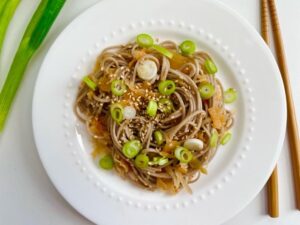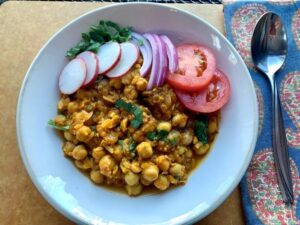
The continent of Asia is enormous, and so is its gastronomy.
We lean on the Asian Heritage Diet Pyramid year-round to bring the pattern of Asian cooking to our kitchens. From ginger to brown rice to tofu, there are so many ingredients that can be found all across Asia and incorporated into dishes that go even beyond the continent because, at the end of the day, Oldways heritage diets are more alike than different.
 As much as we love the common overall pattern of Asian Heritage cooking, May is Asian American and Pacific Islander Heritage Month, which means it is the perfect time to get more granular and explore the unique flavors of regional Asian specialties.
As much as we love the common overall pattern of Asian Heritage cooking, May is Asian American and Pacific Islander Heritage Month, which means it is the perfect time to get more granular and explore the unique flavors of regional Asian specialties.
Asian heritage diets also feature a number of heart-healthy food groups and traditional cooking practices, as detailed in a new culinary infographic produced in collaboration with Oldways and the American Heart Association.
Let the Asian heritage diet be your guide as you travel the continent, via your kitchen!
East Asia
Hoisin Scallops with Vegetable Noodles: Seafood is a key component of all our heritage diet pyramids. This delicious scallop dinner can be ready in 30 minutes and uses vegetables that are available year-round.
Kale and Shiitake Mushroom Bowl: “Umami” – used to describe a pleasant, savory taste – is considered one of the basic tastes in Japan, alongside sweet, bitter, etc. The shiitake mushrooms account for the umami flavor in this dish, and alongside the toastiness of the almonds and the warming flavor of the sage, this is the perfect treat for a rainy day.
 Chinese Cashew Shrimp Stir Fry: Cashew shrimp stir fry is a Cantonese dish, so this is the type of meal that you might expect to find in parts of Southeastern China. Stir frying, where foods are quickly cooked over high heat in a large wok, is a popular cooking method throughout China. This dish is also a great example of how nuts, like cashews, are incorporated into creative seafood, meat and vegetable dishes throughout China.
Chinese Cashew Shrimp Stir Fry: Cashew shrimp stir fry is a Cantonese dish, so this is the type of meal that you might expect to find in parts of Southeastern China. Stir frying, where foods are quickly cooked over high heat in a large wok, is a popular cooking method throughout China. This dish is also a great example of how nuts, like cashews, are incorporated into creative seafood, meat and vegetable dishes throughout China.
Kimchi Soba (Buckwheat Noodles): This is a great buckwheat noodle dish, served either hot or cold, that has a serious kick to it!
South Asia
Aloo Gobhi: Potatoes and cauliflower become fragrant and mildly spicy in this Indian-inspired dish with cumin, fennel, coriander and ginger. A sprinkling of fresh cilantro on top adds freshness.
Besan Onion Cheele: In Indian cuisine, cheele are savory crepes typically served with chutney or plain yogurt for breakfast. The most popular cheele are made with besan (chickpea or garbanzo bean flour), giving the dish a boost of protein.
 Bulgur Vegetable Uppama: Uppama is a savory, delicious, grain-based breakfast dish that is often made with cream of wheat in South India. This version uses whole grain bulgur wheat and features lots of vegetables.
Bulgur Vegetable Uppama: Uppama is a savory, delicious, grain-based breakfast dish that is often made with cream of wheat in South India. This version uses whole grain bulgur wheat and features lots of vegetables.
Brown Rice Bowl with Chana Masala and Curry Cauliflower: In Indian cuisine, a thaali meal is one in which a variety of small dishes are served together as a complete meal. This brown rice bowl is somewhat like an Indian thaali, except all served together in one delicious bowl. Feel free to customize it with your own favorite toppings or vegetables.
Adrak Masoor Dal (Ginger Pink Lentils): Ginger, cumin and coriander add delicious flavor to this quick-cooking lentil dish. Enjoy these lentils served over rice or scooped with whole grain flatbread or serve in a small bowl as a hearty and warming soup!
Southeast Asia
Thai Green Curry with Eggplant and Tofu: Plant-based dishes really shine in Southeast Asia. Combine flavorful green curry paste with light coconut milk, cubes of tofu, sliced eggplant, mushrooms and bell pepper to create a delicious meal served over brown rice.
Multigrain Banh Mi: This Vietnamese dish is traditionally made by filling a baguette with a protein of choice, carrots, cucumber, cilantro, mayo and an assortment of individualized flavors. This version calls for a multigrain baguette to add flavor, texture and nutrition to an already delicious staple.
 Basil Chicken (Phat Kaphrao): This is a quick and easy street food staple that is traditionally a fiery one, but you can tame the heat by using fewer chilis, a different varietal or none — it will still be flavorful. The fried egg on top is also traditional, but not necessary.
Basil Chicken (Phat Kaphrao): This is a quick and easy street food staple that is traditionally a fiery one, but you can tame the heat by using fewer chilis, a different varietal or none — it will still be flavorful. The fried egg on top is also traditional, but not necessary.
Adobo-Inspired Vegetables: Adobo is a Filipino chicken or pork dish braised in a sweet-and-sour vinegar sauce. These vegetables are inspired by those flavors, roasted, and then cooked in a mixture of rice vinegar, soy sauce, lime juice, and lots of black pepper and garlic.
Fish Pho with Buckwheat Noodles: The origins of pho have been debated for years, with China and France boasting influence over this versatile Vietnamese dish. A fragrant vegetable stock poaches the fish, cooks the vibrant Chinese vegetables and five-spice tofu, and warms the buckwheat noodles.
Though this list is just the tip of the iceberg when it comes to the fabulous flavors of Asia, it serves as a starting point. We love using cooking as a show of appreciation for the culture a given dish stems from, and this month is the perfect opportunity to do just that. Dive into one of these meals, check out more information on the Asian heritage diet, or explore additional recipes – happy Asian American and Pacific Islander Month!




Leave a comment